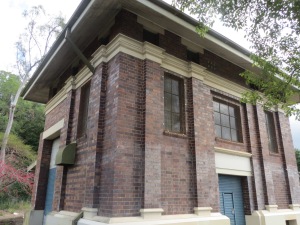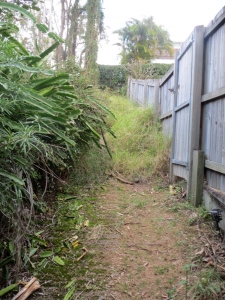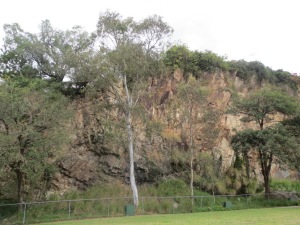
 NO matter how much the main road into the CBD from Gympie has changed, the stone cliffs at Windsor have always remained prominent and somewhat at odds with their environment – a quarry almost in the middle of a city?
NO matter how much the main road into the CBD from Gympie has changed, the stone cliffs at Windsor have always remained prominent and somewhat at odds with their environment – a quarry almost in the middle of a city?
I must admit I didn’t even know it was a quarry at first, for years thinking it was just a rocky cliff face that for some reason had escaped development.
I now wonder what the place would look like if the other part of the hill wasn’t missing.
The cliffs are near the old Windsor Council Chambers . (It was actually on a visit to the cliffs that I discovered the quaint stone council building.)
The name Brisbane Tuff (as in “woof”) has come up at a number of magnificent early buildings in Brisbane, as the Windsor site along with the Kangaroo Point Cliffs were the main suppliers of stone to the colony.
Today, there’s a 0.66ha park at the base of the cliffs, separating them from the council building and creating a most pleasant place to stop in and visit.

Nearby is also another of the rather extravagant brick power substations built by the Brisbane City Council in the 1920s to provide power for the tram service.
There are also a couple of signs to explain the historical and geological significance of the area while you’re there.
Houses line the top of the cliffs and although I answered the call of a set of steps inviting me to walk up and check out their views, the path soon disappeared into a mass of weeds and overgrowth.
It obviously once went somewhere though, as there were front gates for the homes at the top, which clearly once faced a street here.

Now, back to the quarry and Brisbane Tuff.
It was hailed a wonder rock and quarried from the days of first settlement in Brisbane.
Kangaroo Point quarry came first, supplying stone for many early buildings, one of the first being the Commissariat Store in 1829, as well as for ballast in the sailing ships.
The Windsor Town Quarry was on land acquired in Crown land sales by Nehemiah Bartley, a colonial wanderer, merchant and author, in 1859.
He bought much of the hilly land in the area during this time but sold most of it during the recession of the mid-1860s.
The quarry supplied materials for making roads in the 1860s after Bowen Bridge was built across Breakfast Creek at Herston.
After Windsor Shire Council was formed in 1887, it took over control of the quarry and used the stone to build its council chambers a decade later.

The Windsor and District Historical Society says that during the Depression of the 1890s, relief work was given only to married men and their task was to smash the Tuff into gravel for a mere one shilling and sixpence a week.
A stone crushing plant was built in 1914 and it contributed greatly to road development with materials transported by horse and dray into the streets of Brisbane.
By the 1920s, it was mined out and the quarry closed.
The rock face is now preserved as part of the park and is used by university students study its unique rock formations.
Only one death was recorded in its heyday. In 1900, 15-year-old George Thomas Warland was killed when he fell while birdnesting.

For the geological record, Brisbane Tuff is a volcanic sediment deposited in a single cataclysmic event. Lava, pumice and rock fragments blown out of a volcano in a huge explosion formed layers on landing, which were then welded together by the extreme heat to form Tuff.
The old quarry cliffs at both Windsor and Kangaroo Point today make a dramatic display each night when they are floodlit.
Related articles
- Day 64: Wise council (brismania.com)
The going rate for smashing stones for road gravel was 1/6 per cubic yard, not 1/6 per week.
Warland was not the only death from the wall of the quarry.
Comments are closed.